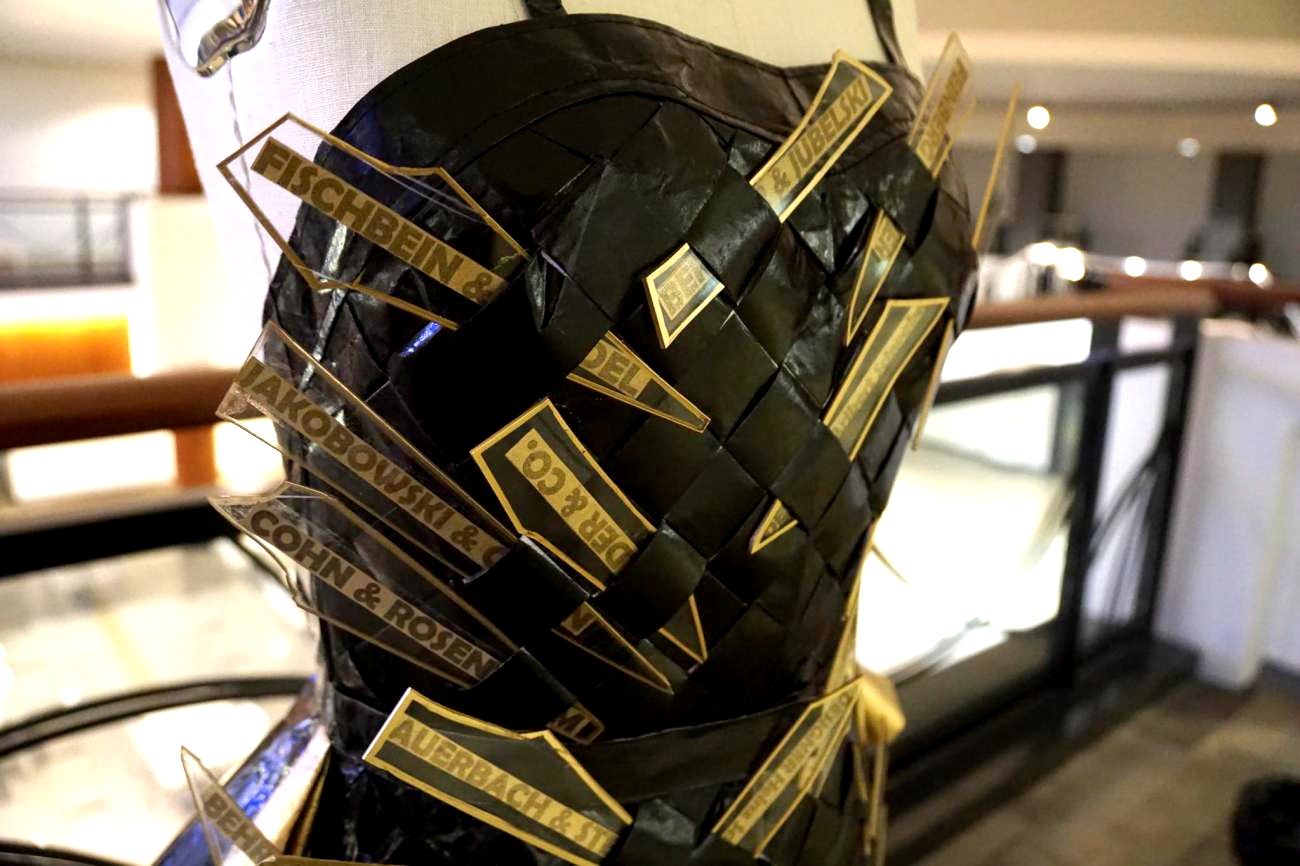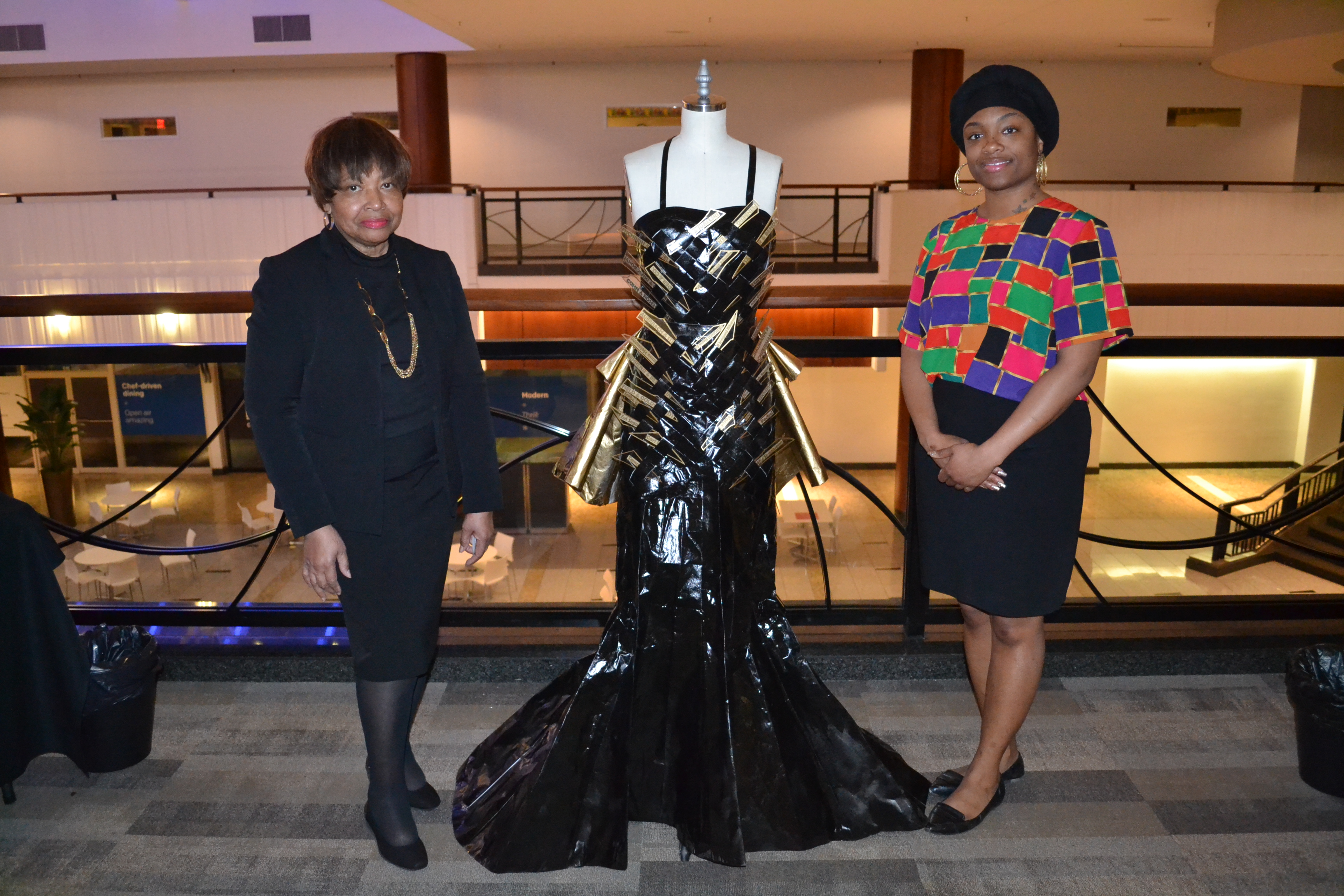

A 1940s-style dress pierced by 30 shards of jagged acrylic, each bearing the name of a Jewish-owned company, shop or designer victimized under the Hitler regime.
By Dina Gold
Few people these days are aware that Berlin, in the 1920s and early 1930s, was the capital of the world’s fashion industry. And this illustrious position was almost exclusively thanks to Jewish innovators in business, design, photography and journalism. But the invaluable contribution of Jewish Germans has been forgotten—until now.
With a brand new travelling exhibition, designed by the Georgia Commission on the Holocaust, the long-lost history of German Jewry’s involvement in the world of fashion is about to get the recognition it so richly deserves. “Fashioning a Nation: German Identity and Industry, 1914-1945” charts the incredible story of German fashion, which once boasted 2,400 Jewish clothing firms, through to its ultimate destruction by the Nazis. This exhibition is the first of its kind.
“The history of the Holocaust overwhelms us with stories of pain and loss,” says Sally N. Levine, executive director at the Georgia Commission on the Holocaust. “In our effort to comprehend this enormous tragedy, honor the survivors and memorialize the victims, we may overlook another aspect of the narrative: the large-scale theft of Jewish businesses and properties. The exhibition…provides us with a unique lens with which to bring the history of the Holocaust to a wider audience. By the end of the exhibition, we are left to contemplate the great human, cultural and economic losses resulting from Nazi policy to exclude Jews from German life, expropriate their property and ultimately send them off to their deaths.”

A 1932 ad featuring a dress by Lissy Edler, a Jewish German fashion designer at the Loeb & Levy fashion firm. Edler emigrated to the United Kingdom in 1936. Photo courtesy of Uwe Westphal.
Berlin’s Hausvogteiplatz, a square in the Mitte district of Berlin, was the birthplace of the German Konfektion (ready-to-wear) industry. German designers attended Paris fashion shows and reproduced in standard sizes, on a mass scale, the haute couture clothing they saw on the catwalks. Subcontractors and home seamstresses enabled Berlin Konfektion firms to export to Brazil, the Netherlands, the United Kingdom, Sweden, Switzerland and even the U.S. Where formerly only the wealthy had been able to indulge in fashionable couture, inexpensive and trendsetting clothing became available to the masses.
The Third Reich’s persecution of Jews began almost immediately after the Nazis took power in 1933. Jews comprised less than 1 percent of the German population, but many Jewish families had lived in Germany for generations. They were proud to identify as Germans, which made the persecution even more difficult to confront. Jewish businesses were targeted with boycotts, mortgages were foreclosed on and owners were forced to sell their properties and companies far below their market value—and often for no payment whatsoever. The pogrom of Kirstallnacht (which means “Night of Crystal,” often referred to as the “Night of Broken Glass”) in 1938 left thousands of Jewish-owned clothing shops looted, burnt and ruined. By the end of 1939, the German fashion industry had been completely “Aryanized”—freed from Jews—by the Nazis and their collaborators.
America—and other countries—benefitted from the skills of those Jewish German fashion designers who managed to escape Germany and start their businesses afresh. Those unable to escape met the same tragic end as millions of other European Jews.
Recognizing the power that fashion holds economically and culturally, the Nazis tried—and failed—to limit German women’s wardrobe to two looks: the dirndl, a traditional folk costume, or the uniform. But although Nazi propaganda was successful in many other aspects, it had little impact on most German women. Even the wives of prominent Nazis continued to follow international fashion trends—even if that meant commissioning dresses from designers abroad who also happened to be Jewish. And the influence of Jews could still be detected within German fashion itself. Despite the great cultural loss resulting from the Holocaust, popular styles continued to bear the hallmarks of the designs of former Jewish Germans.
Emma Ellingson, public Education Manager at the Georgia Commission on the Holocaust, has researched and created 16 illustrative panels charting the rise, Golden Age and ultimate demise of the German fashion industry. “This exhibition not only honors the legacy of Jewish Germans, without whom there would not have been a successful fashion industry, but it is also about the fashion itself and what it meant to Germans,” she says. “Clothing is incredibly personal. Its value is based in practical purpose and individual meaning. For German women in the early half of the 20th century, it was one area in daily life in which they had almost full agency to express themselves. The meaning clothing holds in terms of personal identity is something I think both men and women today can relate to and, through that connection, learn about this little known chapter in a horrific period of history.”
Berlin’s entire creative fashion industry, once so heavily Jewish-dominated, was destroyed. The effects of that destruction remain to this day, more than 70 years later. In trying to resume its place at the pinnacle of the fashion world, Berlin design companies are now struggling to find new talent.

Fashion designer Cynthanie Sumpter and her student Lenora Gray.
Arriving from Germany to speak on a panel at the opening of the exhibition, Uwe Westphal, author and historian who has studied the Jewish fashion industry in Berlin, pointed out that “German fashion firms have conspicuously failed, right up to the present day, to acknowledge publicly the tragedy of what happened to the creators of Berlin’s clothing industry. The current lack of design talent today in Germany is a direct result of that.”
Cynthanie Sumpter, fashion designer and senior lecturer in the Department of Art and Fashion at Clark Atlanta University, attended the opening event for the exhibition held at the Goethe-Zentrum/German Cultural Center in Atlanta, Georgia. She told Moment that she had been inspired by the film Schindler’s List and had been shocked when she learned what happened during Kristallnacht. Together with two of her students, seniors Lenora Gray and Niambi Davenport, she designed a dress in memory of the Jewish owners and employees of the German fashion industry who were persecuted and killed. Made of rolled white craft paper and spray painted black and gold, the 1940s-style dress with a woven bodice is pierced by 30 shards of jagged acrylic (with the appearance of broken glass, symbolizing the shattered glass of Kristallnacht), each bearing the name of a Jewish-owned company, shop or designer victimized under the Hitler regime. Lenora Gray said it had been “an honor to recreate a dress that left such a legacy.” Something new and meaningful has been created from what the Nazis and their collaborators destroyed.
“Fashioning a Nation: German Identity and Industry, 1914-1945″ is on display on the Plaza Level of Colony Square Mall until January 23, 2017. It will then be on show at the Georgia Commission on the Holocaust’s permanent exhibit “Anne Frank in the World: 1929-1945” in Sandy Springs before it goes on a statewide tour to universities, libraries, and community centers.

3 thoughts on “Jewish Germans and the History of Fashion”
Will this exhibit come to New York?
The Georgia Commission on the Holocaust reports that there are currently no plans to display the exhibit outside the state of Georgia.
This exhibition is extraordinary and unique! It will take you on a both sensual and intellectual time travel to the brightest and darkest moments in Germany’s fashion industry who was, unknown to many, dominated by Jewish couturiers in Berlin. For the first time, text and textiles tell their story in a fun yet educational way – how they brought “elite” designs to department stores, how their businesses thrived, and, how it all ended when they were expropriated, if not killed, by the Nazis. A must-see for everyone in the area – and hopefully there will be ways to display the exhibit in many other places across the US.